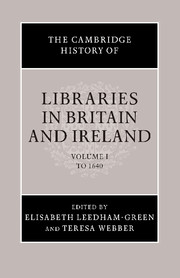Book contents
- Frontmatter
- Introduction
- The physical setting
- Part One The medieval library
- 2 Celtic Britain and Ireland in the early middle ages
- 3 Anglo-Saxon England
- 4 Monastic and cathedral book collections in the late eleventh and twelfth centuries
- 5 The libraries of religious houses in the late middle ages
- 6 College and university book collections and libraries
- 7 Bishops and kings: private book collections in medieval England
- 8 The medieval librarian
- 9 Borrowing and reference: access to libraries in the late middle ages
- Part Two Reformation, dissolution, new learning
- Part Three Tools of the trade
- Part Four Libraries for leisure
- Part Five Organisation and administration
- Select bibliography
- General index
- Index of manuscripts
- References
5 - The libraries of religious houses in the late middle ages
from Part One - The medieval library
Published online by Cambridge University Press: 28 March 2008
- Frontmatter
- Introduction
- The physical setting
- Part One The medieval library
- 2 Celtic Britain and Ireland in the early middle ages
- 3 Anglo-Saxon England
- 4 Monastic and cathedral book collections in the late eleventh and twelfth centuries
- 5 The libraries of religious houses in the late middle ages
- 6 College and university book collections and libraries
- 7 Bishops and kings: private book collections in medieval England
- 8 The medieval librarian
- 9 Borrowing and reference: access to libraries in the late middle ages
- Part Two Reformation, dissolution, new learning
- Part Three Tools of the trade
- Part Four Libraries for leisure
- Part Five Organisation and administration
- Select bibliography
- General index
- Index of manuscripts
- References
Summary
A medieval library was not a place so much as a process, a shifting accumulation of changing materials housed in diverse locations, which responded, to a greater or lesser degree, to a variety of trends in the cultural, educational, social, economic, political and intellectual milieux of its time and place. To trace its evolution, therefore, among all orders, from Augustinians to Premonstratensians, both male and (where applicable) female, is a daunting task and in some cases (for lack of information) simply impossible. Yet a careful examination of the surviving evidence enables us to draw a number of informed conclusions, and the broad lines of development, like the song the Sirens sang, are not beyond all conjecture.
The period with which we are concerned was one of dramatic change in the complex life of the islands of Britain, and it was not a period of unalloyed peace and prosperity. The period spanning the fourteenth and early fifteenth centuries, for example, was one of major climatic change, when Britain was ravaged repeatedly by famine and disease. Book collections do not develop in a vacuum, and we cannot blame a Cistercian abbot whose monks are dying from plague or whose sheep are dying from liver-rot for neglecting his library. But towards the end of the fifteenth century, there was a remarkable recovery in prosperity and a significant increase in disposable income, and since, in a number of areas, child labour now became dispensable, schooling improved and literacy grew. It is no coincidence that this was a period of intellectual and cultural reawakening, when we see ‘an increase in the demand for, availability and ownership of books of all kinds’.
- Type
- Chapter
- Information
- The Cambridge History of Libraries in Britain and Ireland , pp. 126 - 151Publisher: Cambridge University PressPrint publication year: 2006
References
- 1
- Cited by



